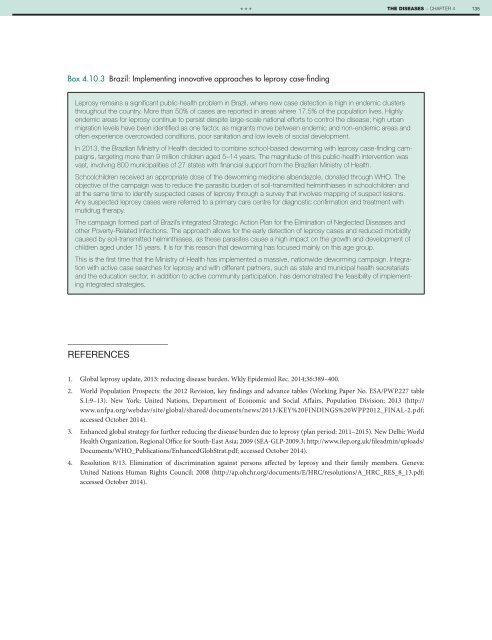1A9bnbK
1A9bnbK
1A9bnbK
You also want an ePaper? Increase the reach of your titles
YUMPU automatically turns print PDFs into web optimized ePapers that Google loves.
***<br />
THE DISEASES − CHAPTER 4<br />
135<br />
Box 4.10.3 Brazil: Implementing innovative approaches to leprosy case-finding<br />
Leprosy remains a signifi cant public-health problem in Brazil, where new case detection is high in endemic clusters<br />
throughout the country. More than 50% of cases are reported in areas where 17.5% of the population lives. Highly<br />
endemic areas for leprosy continue to persist despite large-scale national efforts to control the disease; high urban<br />
migration levels have been identifi ed as one factor, as migrants move between endemic and non-endemic areas and<br />
often experience overcrowded conditions, poor sanitation and low levels of social development.<br />
In 2013, the Brazilian Ministry of Health decided to combine school-based deworming with leprosy case-fi nding campaigns,<br />
targeting more than 9 million children aged 5–14 years. The magnitude of this public-health intervention was<br />
vast, involving 800 municipalities of 27 states with fi nancial support from the Brazilian Ministry of Health.<br />
Schoolchildren received an appropriate dose of the deworming medicine albendazole, donated through WHO. The<br />
objective of the campaign was to reduce the parasitic burden of soil-transmitted helminthiases in schoolchildren and<br />
at the same time to identify suspected cases of leprosy through a survey that involves mapping of suspect lesions.<br />
Any suspected leprosy cases were referred to a primary care centre for diagnostic confi rmation and treatment with<br />
mutidrug therapy.<br />
The campaign formed part of Brazil’s integrated Strategic Action Plan for the Elimination of Neglected Diseases and<br />
other Poverty-Related Infections. The approach allows for the early detection of leprosy cases and reduced morbidity<br />
caused by soil-transmitted helminthiases, as these parasites cause a high impact on the growth and development of<br />
children aged under 15 years. It is for this reason that deworming has focused mainly on this age group.<br />
This is the fi rst time that the Ministry of Health has implemented a massive, nationwide deworming campaign. Integration<br />
with active case searches for leprosy and with different partners, such as state and municipal health secretariats<br />
and the education sector, in addition to active community participation, has demonstrated the feasibility of implementing<br />
integrated strategies.<br />
_____________________<br />
REFERENCES<br />
1. Global leprosy update, 2013: reducing disease burden. Wkly Epidemiol Rec. 2014;36:389–400.<br />
2. World Population Prospects: the 2012 Revision, key findings and advance tables (Working Paper No. ESA/PWP.227 table<br />
S.1:9–13). New York: United Nations, Department of Economic and Social Affairs, Population Division; 2013 (http://<br />
www.unfpa.org/webdav/site/global/shared/documents/news/2013/KEY%20FINDINGS%20WPP2012_FINAL-2.pdf;<br />
accessed October 2014).<br />
3. Enhanced global strategy for further reducing the disease burden due to leprosy (plan period: 2011–2015). New Delhi: World<br />
Health Organization, Regional Office for South-East Asia; 2009 (SEA-GLP-2009.3; http://www.ilep.org.uk/fileadmin/uploads/<br />
Documents/WHO_Publications/EnhancedGlobStrat.pdf; accessed October 2014).<br />
4. Resolution 8/13. Elimination of discrimination against persons affected by leprosy and their family members. Geneva:<br />
United Nations Human Rights Council; 2008 (http://ap.ohchr.org/documents/E/HRC/resolutions/A_HRC_RES_8_13.pdf;<br />
accessed October 2014).


